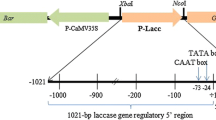Abstract
The activity of six different promoter-gus (uidA) binary plasmid constructs has been analysed in transgenic roots of Pinus contorta, Nicotiana tabacum, Lycopersicon esculentum and Arabidopsis thaliana. Transgenic roots were induced by infection with Agrobacterium rhizogenes strain LBA9402, harbouring a binary plasmid construct that contained one of the following promoters: Ubi-1 from Zea mays, 35S from CaMV, cdc2a and sam-1 from A. thaliana, HRGPnt3 from N. tabacum and RSI-1 from L. esculentum. Promoters of broad tissue specificity (cdc2a, Ubi-1 and 35S) showed GUS staining in most cell types of all the species. The other three promoters were expressed specifically in lateral root primordia. The studies of gene activity in primary transgenic roots allowed the screening of candidate promoters related to lateral and adventitious root formation within 3–6 weeks after inoculation in the angiosperm species and 2–3 months in P. contorta.
Similar content being viewed by others
Author information
Authors and Affiliations
Additional information
Received: 30 September 1998 / Revision recieved: 10 November 1998 / Accepted: 30 November 1998
Rights and permissions
About this article
Cite this article
Lindroth, A., Grönroos, R., Clapham, D. et al. Ubiquitous and tissue-specific gus expression in transgenic roots conferred by six different promoters in one coniferous and three angiosperm species. Plant Cell Reports 18, 820–828 (1999). https://doi.org/10.1007/s002990050668
Issue Date:
DOI: https://doi.org/10.1007/s002990050668




